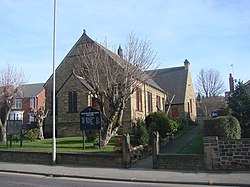Smithies, Yorkshire
| Smithies | |
| Yorkshire West Riding | |
|---|---|
 Wesleyan Reform Church, Smithies | |
| Location | |
| Grid reference: | SE354084 |
| Location: | 53°34’16"N, 1°28’1"W |
| Data | |
| Post town: | Barnsley |
| Postcode: | S71 |
| Dialling code: | 01226 |
| Local Government | |
| Council: | Barnsley |
| Parliamentary constituency: |
Barnsley Central |
Smithies is an old village of the West Riding of Yorkshire, which has become subsumesd as an area of Barnsley, about two miles north-east of the town centre.
Smithies was historically a village in the township of Monk Bretton in the parish of Royston. The civic borders of Barnsely swallowed it 1921 to enable the village to be thoroughly urbanised.
Coal mining
A number of collieries were worked in Smithies between 1856 and 1929. East Gawber Hall Colliery, located to the north of the village, opened in 1856 and was worked until the First World War. The remains of the colliery's Guibal fanhouse, built around 1875, are listed as a historic monument.[1]
The Wallsend Main Colliery was sunk before 1901.[2] and was worked with the adjacent Primrose Main Colliery,[3] which was working before 1891.[4][5] The Wallsend Main Colliery Company was wound up in January 1921.[6]
The Central Silkstone Colliery was sunk in 1907.[7] It was purchased by the East Barnsley Colliery Company (based in Smithies) around 1919,[8][9] and continued in use until at least 1924.
Wharncliffe Carlton Colliery on the south edge of Smithies was notorious for an explosion in October 1883 that killed 20 miners.[10] While the inquest was being held about the initial explosion, a second underground blast severely injured two more men.[11] The colliery was connected underground with East Gawber Hall, and after the disaster, Wharncliffe Carlton was sealed off from East Gawber Hall and flooded to quench the underground fires, before it could be re-opened.[12]
By 1929, all of the collieries had closed and been demolished.
Outside links
| ("Wikimedia Commons" has material about Smithies, Yorkshire) |
References
- ↑ National Heritage List 1017748: East Gawber Hall colliery fanhouse, north-east of Croft Farm (Scheduled ancient monument entry)
- ↑ "List of Mines in the United Kingdom of Great Britain, Ireland and the Isle of Man". Home Office. 1902.
- ↑ Template:Cite report
- ↑ "The Bankruptcy Acts: Receiving Orders". The London Gazette 26236: 7179. 25 December 1891.
- ↑ Skinner, W.R. (1909). Mining Yearbook. pp. 673–674.
- ↑ "Joint Stock Companies". The London Gazette 32196: p. 477. 18 January 1921.
- ↑ "Barnsley Miners Receive Notice". Sheffield Daily Telegraph. 21 June 1909.
- ↑ Skinner, Walter Robert; Skinner, Walter E. (1919). "Mining Manual Containing Full Particulars of Mining Companies". Financial Times.
- ↑ "The Law Times Reports of Cases Decided in the House of Lords, the Privy Council, the Court of Appeal". 124. Butterworth. 1921.
- ↑ "The Explosion at Wharncliffe Carlton Colliery". Nottingham Evening Post. 5 March 1884.
- ↑ "Another Explosion at Wharncliffe Carlton Colliery". Manchester Courier and Lancaster General Advertiser. 27 October 1883.
- ↑ "The Wharncliffe Colliery Explosion". St. James Gazette. 24 October 1883.
